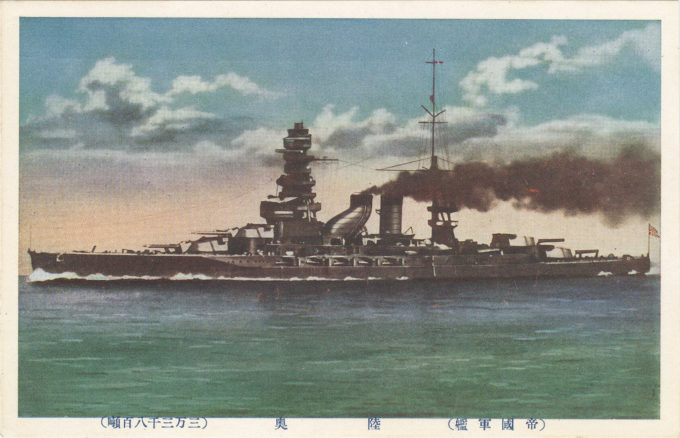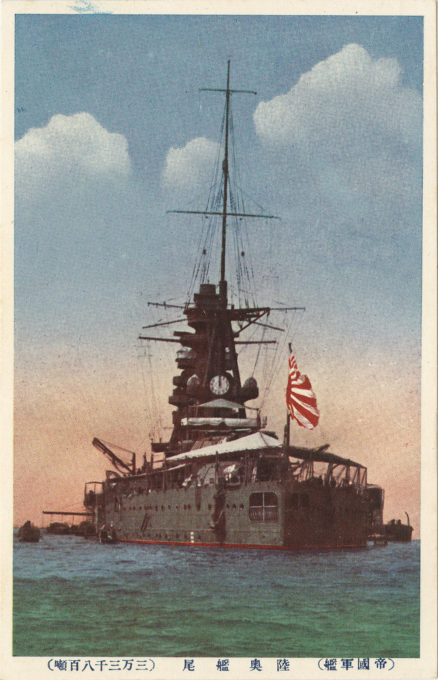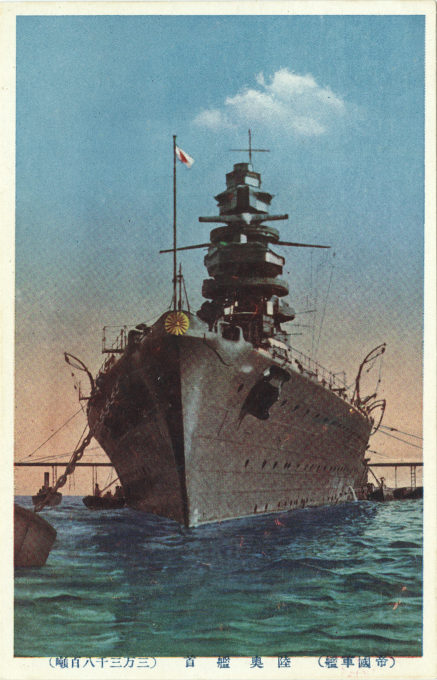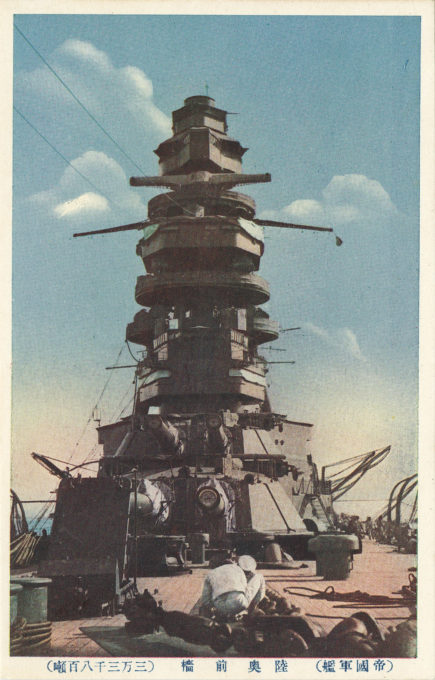See also:
Imperial Japanese Navy Battleship “Nagato”, c. 1925.
“‘Eight-Eight’ Fleet Program”, Imperial Japanese Navy, c. 1925.
“After World War II most of the Imperial Japanese Navy’s battleships were at the bottom of the sea or scrapped, leaving the pre-dreadnought-turned-memorial ship Mikasa, victor of the 1905 Battle of Tsushima, as Japan’s sole survivor. Yamato is Japan’s most famous battleship, but except for some small artifacts, none of the ship has been raised. Other than Mikasa, if you want to see a Japanese battleship there are parts spread around the country: guns, turrets, anchors … And they all came from the same battleship, Mutsu.
“A contemporary of USS Arizona (BB-39), Mutsu was a Nagato-class super-dreadnought laid down toward the end of World War I in Yokosuka and commissioned in 1921. On the day of her launch she was the most powerful surface combatant ever built … The Nagato-class had eight [41 cm/16.1 in] guns mounted in four twin turrets. In addition she had eight torpedo tubes.
“… Her [Pacific War] career was mostly spent training in Japan’s home waters except for a deployment in support of the Midway operation and for the Battle of the Eastern Solomons. She was 300 miles away when the Battle of Midway happened and so played no part, but did give fire support during the latter battle.
“This quiet existence came to a sudden and violent end on Jun. 8, 1943 at the Hajirashima anchorage in Japan’s Seto Inland Sea on Jun. 8, 1943 … Without warning her No. 3 turret magazine detonated just past noon with an explosion so powerful that it broke the ship in two. Her forward section with the tall pagoda mast overturned and quickly sank. Her aft end stayed afloat until the following morning before it sank as well. Only 353 of her 1,474 man crew and 13 civilian visitors on board survived.
“The accident was quickly covered up and the survivors sent to far flung garrisons where they couldn’t accidentally leak that Japan lost a capital ship in protected home waters without a known cause. Many would die a year later [1944] at Saipan as a result.
“Initially the detonation was suspected to have been caused by sanshiki explosive anti-aircraft shells for the 16” guns … There was also fear that an Allied submarine may have somehow penetrated the anchorage defenses and made the kill, but there was no evidence of that either. Sabotage by a disgruntled crewman was also suspected and investigated. Ultimately, there has never been a definitive answer as to why her magazine exploded.
“Though gone, Mutsu is now in a way Japan’s national memorial battleship because her parts have been spread far and wide across the country, giving many the chance to get up close to what were once the most powerful guns mounted on a warship and a symbol of Japan’s modernizing military.”
– “Mutsu: Japan’s Most Visitable Battleship”, by David Krigbaum, Wayfarer Dave’s Travel & History Blog, 2017
- Battleship Mutsu bow view, c. 1925.
- Battleship Mutsu foreward turrets and bridge, c. 1925.
“Mutsu was the second Nagato-class dreadnought battleship built for the Imperial Japanese Navy (IJN) at the end of World War I. It was named for the feudal-era province, Mutsu, that once occupied a wide swath of northeastern Japan that is now Fukushima, Miyagi, Iwate and Aomori Prefectures.
“Mutsu was laid down at the Yokosuka Naval Arsenal on 1 June 1918 and launched on 31 May 1920. Funding for the ship had partly come from donations from schoolchildren.
“While Mutsu was still fitting out, the Washington Naval Conference was convened in November 1921 by the United States, the United Kingdom and the Empire of Japan to forestall a looming, expensive naval arms race. The United States proposed scrapping virtually every capital ship under construction or being fitted out by the participating nations.
“Mutsu was specifically listed among those to be scrapped even though she had been commissioned a few weeks earlier. This was unacceptable to the Japanese delegates; they agreed to a compromise that allowed them to keep Mutsu in exchange for scrapping the obsolete dreadnought Settsu, with a similar arrangement made for three American Colorado-class dreadnoughts that were fitting out and also listed for scrapping.
“Mutsu was commissioned on 24 October 1921 and the ship was assigned to the 1st Battleship Division on 1 December. Mutsu hosted Edward, Prince of Wales, and his aide-de-camp and second cousin, Lieutenant Louis Mountbatten, on 12 April 1922 during the prince’s visit to Japan.
“In September 1923, Mutsu was loaded with supplies for the victims and survivors of the Great Kantō earthquake. In 1924, in accordance with the Washington Naval Treaty, Mutsu sank the hulk of the obsolete battleship Satsuma for gunnery practice in Tokyo Bay. Captain Mitsumasa Yonai, later Prime Minister of Japan, assumed command on 10 November 1924. Mutsu served as flagship of Emperor Hirohito during the 1927 naval manoeuvres and fleet review.
“Mutsu again served as the Emperor’s flagship during the annual maneuvers and fleet review in 1933, after which she underwent a lengthy reconstruction. This was completed on 30 September 1936 and Mutsu rejoined the 1st Battleship Division on 1 December 1936.
“In August 1937, she transported 2,000 men of the 11th Infantry Division to Shanghai during the Second Sino-Japanese War. Her seaplanes bombed targets in Shanghai on 24 August before she returned to Sasebo the following day. Mutsu was placed in reserve for a year before being reactivated and refitted in early 1941 in preparation for war.”
– Wikipedia





